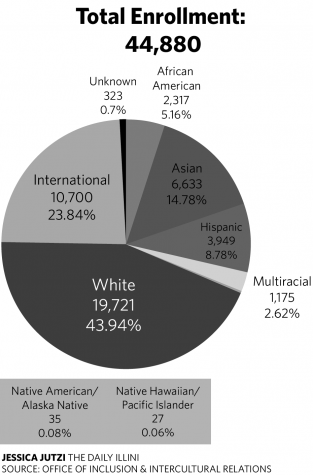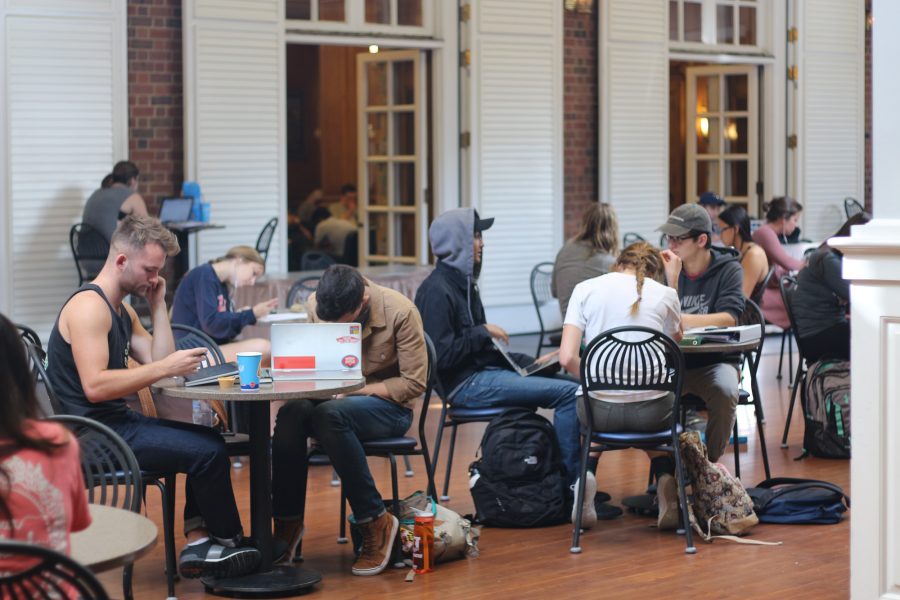As Illinois wins Diversity Award, students question diversity on campus
Students sit and do homework in the Courtyard and the Illini Union.
Oct 12, 2016

For the fourth consecutive year, the University, along with 83 other colleges and universities, has won the 2016 Higher Education Excellence Diversity Award.
The award was presented by Insight Into Diversity magazine — the oldest magazine that promotes diversity in higher educational institutions.
Associate Chancellor for Diversity Assata Zerai noted in a press release that increasing diversity is a major priority for the University.
“Today, we have a vibrant community of diversity and inclusion advocates in the Office of Inclusion and Intercultural Relations, and its related branches in the cultural houses, in the LGBT resources center and the women’s resources center,” Zerai said.
Get The Daily Illini in your inbox!
The University doesn’t just have diversity departments that students can attend for resources, however.
Classes are offered and students are encouraged to watch videos on diversity online. Starting in Fall 2018, a U.S. Minority Culture class will be a graduation requirement.
“Undergraduate students are engaged in DiversityEdu30,” Zerai said. “(It is) an online module that is intended to provide an introduction to the diversity of opinions, social identities, experiences that students will experience at Illinois throughout their academic career and to provide common language where conversations about diversity can begin.”
Although people like Zerai agree that Illinois provides a diverse environment, some might argue that it does not.
Of 44,880 total enrolled students, 5.16 percent are African-American, 14.78 percent are Asian, 8.78 percent are Hispanic, 0.08 percent are Native American/Alaska Native and 0.06 percent are Native Hawaiian/Pacific Islander, according to the Office of Inclusion and Intercultural Relations. International students account for 23.84 percent of the population and 43.94 percent are white.
Chibuihe Asonye, junior in LAS, said in an email, that the University is not as diverse as it pretends to be.
“I think we are superficially a diverse school,” Asonye said. “We see a black kid here or there in a class and so of course we are a diverse place, but there’s only one kid.”
Asonye also said the definition of diversity depends on the context, and that from a University perspective, it’s more a reflection of the state’s population demographic.
“I think diversity is just having the numbers. I think people often mistake diversity with inclusivity. And they are not the same thing,” she said.
Other students agree with Asonye’s definition of diversity. Michelle Pope, junior in LAS, also said that diversity has to do with background and includes more than just race.
“I’m looking at race and educational background,” Pope said. “When I look at diversity, I look at ethical background, educational background and where you live.”
Pope also agrees that the University is not as diverse as it says it is.
“There are a lot of people here from the Chicagoland area. There’s (also) more Asian ethnicities here than African-American people or Mexican people,” Pope said. “I would want it to be more diverse. There are a lot of white people (as well).”
Yet neither Pope nor Asonye are surprised the University won the HEED Award. Pope said that she’s witnessed faculty members talking about the University’s diversity in her classes.
“I was in (General Studies) 101 and they were just bombarding us with how diverse we were,” Pope said. “I thought the class was about General Studies and finding your major, but it’s more about diversity.”
However, Pope expects more from the University.
“I know the school is primarily white people,” Pope said. “I’m not surprised but I (do) wish it was more diverse — it is a Big Ten school.”
Asonye said that the University should strive to be diverse in terms of sexuality, economic background and the LGBTQ community.
“Reach out to (high) schools who aren’t normally on the list, those are the students who need access to this school,” Asonye said.
“I think we should create more of the tailored spaces so students who come here, have a space where they can find other students like themselves.”
Decades ago, the demographics of the student and faculty population were not as inclusive and diverse. In 1946, the University implemented the Code of Fair Educational Practice to address the issue, which was meant to prevent qualifications based on race, creed or national origin, Zerai said.
During that same year, the University also provided accommodations for students with disabilities.
Decades later, over 500 Latino/Latina and African-American students were recruited in 1968.
”The Diversity Realized at Illinois by Visioning Excellence (DRIVE) Committee is composed of highly respected faculty members to ensure that diversity and excellence are an inseparable part of the hiring process, including unconscious bias training,” Zerai said.
In 2007, the University created the Inclusive Illinois initiative. This was the most recent effort to address diversity.
While there are many differing opinions regarding diversity on campus, Zerai sees the progress being made.
“Our goal is to work toward an image of Illinois as a multi-patterned quilt — weaved together cohesively, yet incorporating and respecting the distinct cloths and pieces of our unique identities,” Zerai said.






